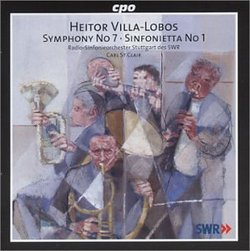| All Artists: Heitor Villa-Lobos, Carl St. Clair, SWR Stuttgart Radio Symphony Orchestra Title: Villa-Lobos: Symphony No. 7; Sinfonietta No. 1 Members Wishing: 0 Total Copies: 0 Label: Cpo Records Release Date: 3/16/2004 Genre: Classical Styles: Historical Periods, Modern, 20th, & 21st Century, Symphonies Number of Discs: 1 SwapaCD Credits: 1 UPC: 761203971329 |
Search - Heitor Villa-Lobos, Carl St. Clair, SWR Stuttgart Radio Symphony Orchestra :: Villa-Lobos: Symphony No. 7; Sinfonietta No. 1
 | Heitor Villa-Lobos, Carl St. Clair, SWR Stuttgart Radio Symphony Orchestra Villa-Lobos: Symphony No. 7; Sinfonietta No. 1 Genre: Classical
|
Larger Image |
CD Details |
CD ReviewsAnother winner from Carl St Clair Wildfire | UK | 04/17/2004 (5 out of 5 stars) "He's done it again! Carl St Clair brings control and balance to Villa-Lobos without sounding the least mechanical about it. He wades through Villa-Lobos' complex rhythms and textures with ease. The balance is exquisite, the salient subject never obscured by the morass of textural things going on in the background (it's there all right, if you care to focus through). St. Clair can sprinkle luminescence on delicate moments yet rises to passion when need be. His rendering of these symphonies (the whole series) has cast new light on the Villa-Lobos repertoire on record. Symphony No 7: without a score or alternative recordings we can only compare it with HVL's output of the same era and the other symphonies. This performance is committed and as competent as you'll hear anywhere. In less sensitive hands the work would be indecipherable. The second movement is about the most lyrical Villa-Lobos I've heard. The fourth movement is the most cluttered - hard to imagine St.Clair could make any more of it as a lot going on the whole time. It points toward the almost impossible textures of the 8th and 9th Choros. The Sinfonietta No 1 was broadcast years ago by the BBC so we have some comparison. Like the contemporary African Dances, 1916, it is approachable and easy going, cast more along the lines of classical harmony and all the evidence one needs of HVL's abilities as composer and orchestrator. It is devoid of the complexities that invaded later HVL. St Clair takes it generally at a moderately brisk pace. The second section, while solemn, is not as subdued as the BBC performance. This recording is a must-have for those who wish to explore HVL beyond the bounds of his ballets and "programme music". Be prepared for pleasant surprises. It's also a recording for those who would like to hear Villa-Lobos' performed properly.We have one more symphony left in this series (unless Mr St Clair has found the 5th, long presumed lost). I'm waiting." Two Faces of Villa-Lobos J Scott Morrison | Middlebury VT, USA | 05/08/2004 (3 out of 5 stars) "Thirty years separate these two works and they couldn't be more different. The Seventh Symphony (1945), although constructed with exquisite craft, is a primitivist Big Statement. The Sinfonietta No. 1 (1916) is a neo-classic jewel based in part on themes of Mozart. I will state at the outset that I am much more responsive to the latter. I tend to be allergic to Big Statements unless they are clearly masterpieces (Missa Solemnis, Mahler 'Resurrection,' Nielsen 'Inextinguishable', say), largely because the temptation toward bloviation is hard for the composer to resist. Villa-Lobos was unable to withstand the urge to go on and on in what, to me, was a pompous and self-important fashion. Although there is expert use of polyphony and form, the instrumentation tends to weigh it down. In fact, the piece sounds to me like a wind band work with strings added almost as an afterthought. At first I thought the thinness of the string-sound was the fault of the string section of the Stuttgart Radio Symphony, but their silken string tone in the Sinfonietta puts the lie to that notion. So, the problem is more likely that of Villa-Lobos simply overpowering us with the brutalist use of wind, brass and percussion. Further, the rhythmic vitality is vitiated by melodic anemia. So, what we have is a rhythmically exciting and instrumentally primitivist symphony that makes use of gray Hindemithian polyphony (albeit Brazil-inflected) in the service of otherwise fairly mediocre materials. The orchestra, under Carl St. Clair, give their all but it simply isn't enough for this listener.On the other hand, I find the early Sinfonietta No. 1 to be delightful throughout. This three movement work was composed at the very beginning of Villa-Lobos's career and is a loving and artful look back at the materials and processes of the classical period (although, in fairness, there is a good deal of Romantic orchestration and emotionality at times). I was put in mind of both Prokofiev's 'Classical Symphony' and Bizet's early 'Symphony in C.' If you know those pieces you will have some idea of the thrust here. This is ingratiating music, and in the middle movement, at 11 minutes the longest of this 21 minute work, there are some melodies that are simply first class, supported by conservative but at the same time sometimes surprisingly piquant harmonies. This piece is given a loving and beautiful performance here. I would nominate the Sinfonietta for repertoire status. I would be hard pressed to recommend this CD for the Sinfonietta alone, but if you also like the sort of the thing that one hears in, say, Villa-Lobos's piano piece, 'Rudepoema' or Silvestre Revueltas's 'Sensamaya,' this might be for you.TT=57:30Scott Morrison"
|

 Track Listings (7) - Disc #1
Track Listings (7) - Disc #1